Vicks Plant, or Plectranthus tomentosa, is a succulent member of the mint family native to South Africa. It’s also known as Plectranthus hadiensis var. tomentosus, Succulent Coleus, and Cuban Oregano. Like other non-succulent mint plants, this easy-to-grow succulent is known for the minty, camphor scent of its leaves.
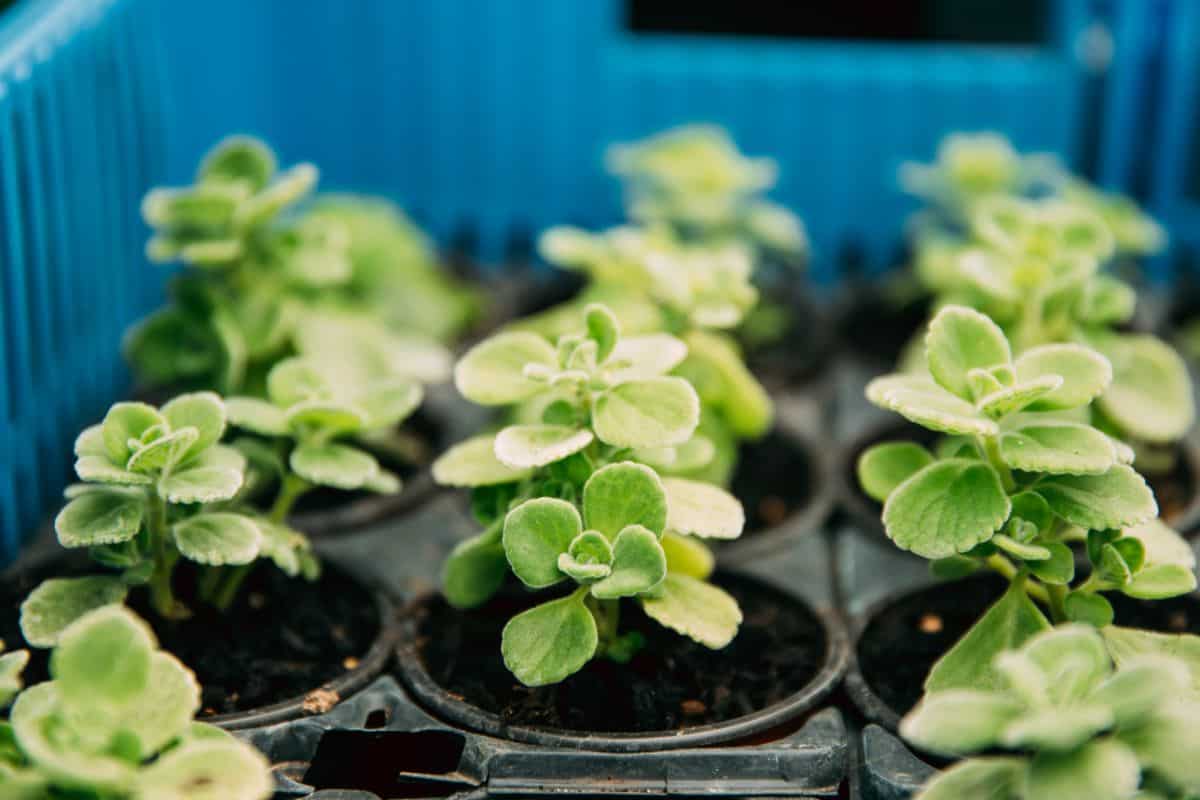
Jump to:
Vicks Plant Appearance
| Name: | Plectranthus tomentosa |
| Soil: | Well-draining soil |
| Blooming: | Early spring and early fall |
| Light: | Bright light |
| Water: | When the soil is dry out |
| Propagation: | Cuttings, offsets, and seeds. |
The Vicks Plant grows in a shrub-like matter and can reach up to 1 foot in height and 2.5 feet in diameter at maturity. The stems of the plant are green but can darken to a woody bark with age.
The aromatic leaves of the Vicks plant tend to be light green in color and roughly egg-shaped with scalloped leaf margins. The leaves are covered in a dense layer of short silvery hairs.
When in bloom, the Vicks plant produces white or light purple flowers. This plant typically blooms twice per year. The first bloom takes place in early spring and the second happens in the fall.
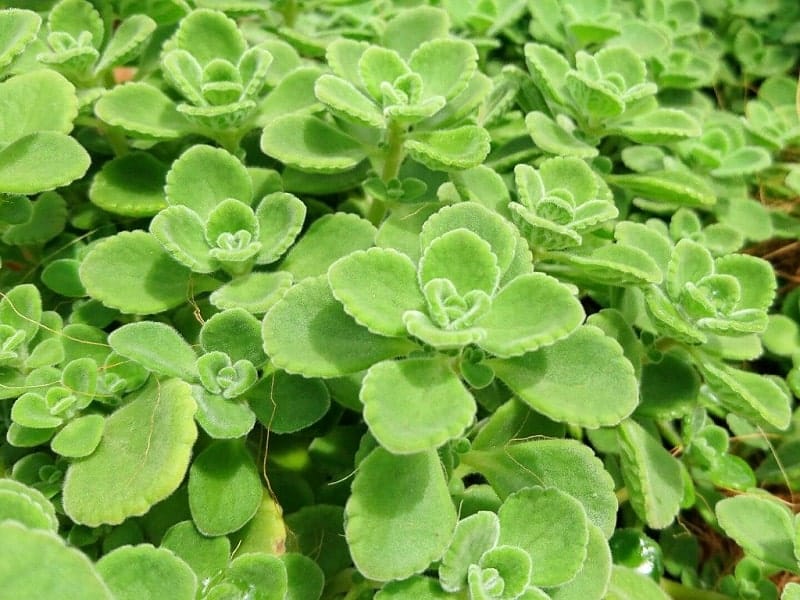
Buy it from:
Caring for Vicks Plant
The Vicks Plant is relatively easy to care for succulent. It’s appropriate for succulent lovers of all experience levels as it can be quite forgiving. This is a plant that does well without the need for extra care or specific conditions.
The Vicks Plant can be easily grown indoors as well as outdoors if the climate permits. They can be grown in containers or in the ground as shrubs as well as ground cover. This versatile plant makes a great addition to any garden.
Water
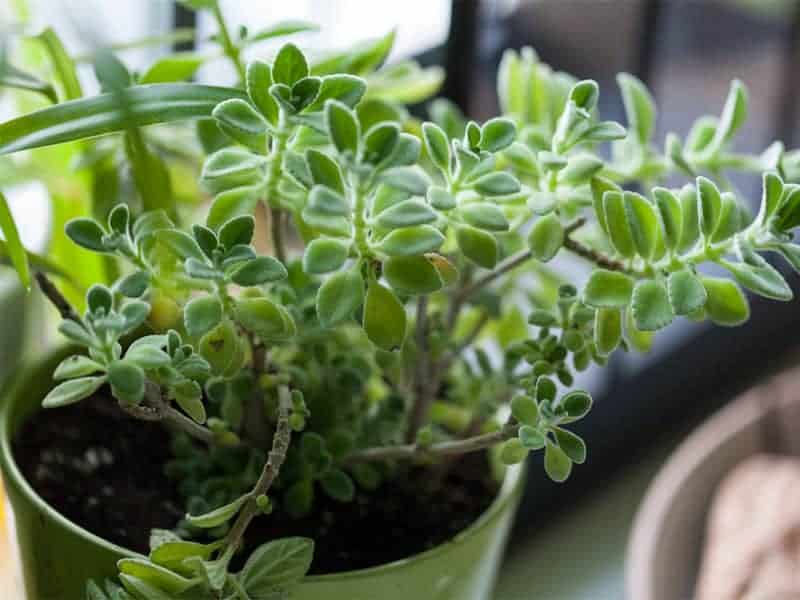
As with all succulents, overwatering should be avoided at all costs. Vicks Plants enjoy more frequent water than many species of succulent, but overly wet soil will still lead to root rot. It’s best to use the soak and dry watering method with these plants.
When watering your Vicks Plant, be sure to give it enough water that the excess drains out of the bottom of the pot. Remember, overwatering is not about the quantity of water you give your succulents, it’s about the frequency. So, once you’ve watered your plant, you’ll want to wait until the soil is dry to water again.
To ensure that the soil is dry, you’ll want to confirm by using either a soil moisture meter or your finger to check. Insert either tool a few inches into the soil near the roots and if moisture is detected, you’ll need to wait a few more days before checking again. If the soil is dry, water freely.
Despite their minty appearance, Vicks Plants are still succulents and do store water in their leaves and stems. This characteristic helps them survive prolonged periods of drought, so if you ever have any doubts about whether you should water or wait, don’t be afraid to err on the side of dryness and wait.
You’ll also need to keep an eye on your plant for signs of overwatering or underwatering. If you aren’t giving your Vicks Plant enough water, you’ll notice the leaves becoming thin, wrinkly, and shriveled. An overwatered plant will have soft, mushy leaves with an almost translucent appearance.
No products found.
With prolonged overwatering, the bottom leaves may also become yellow and eventually fall off. If watering habits are not corrected at this point, root rot will soon take hold. Unfortunately, by the time the signs of root rot are obvious, it’s usually too late to save your beloved succulent.
Light
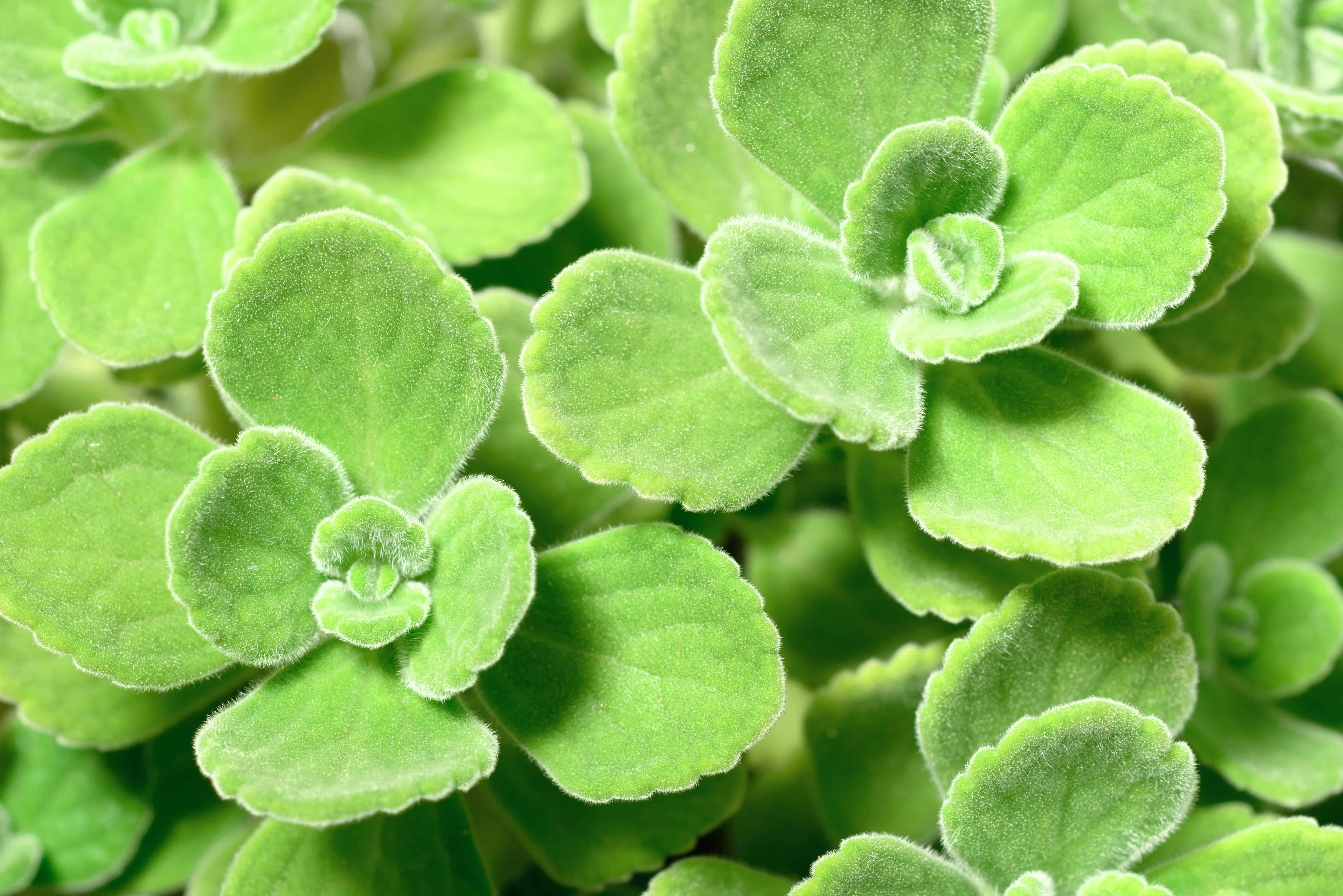
When grown indoors, it’s best to provide your Vicks Plant with plenty of bright light. A south-facing window is ideal, but in many cases, a west or east-facing window will also work. This is not a plant that will do well in a low-light environment.
If you notice your Vicks Plant starting to stretch out toward its light source, you may need to either move it closer to the window or purchase a grow light. With time, your plant will become etiolated without enough light and there’s no other way to fix its stretched-out appearance than to behead it and start over.
When grown outdoors, Vicks Plants do best in full sun or partial shade. Partial shade is preferred in particularly hot climates where the heat of the afternoon combined with direct sun may result in a sunburn.
If you notice areas of your Vicks Plant becoming darkened or discolored after time in direct sun, you may need to move it to a shadier place. Sunburn is rarely fatal but prolonged exposure to too much light can kill a succulent, so it’s important to move the plant as soon as possible.
If your succulent has come from a nursery or you are moving it outdoors for the first time, you should acclimate your Vicks Plant slowly over a period of several weeks to reduce the risk of sunburn. By increasing the amount of time spent in direct sun slowly, you’re giving the plant more time to adapt.
Temperature
Vicks Plants are not frost tolerant succulents, so if you are expecting temperatures to drop below freezing, you’ll need to bring your plant indoors. If you live in an area where winters are typically frigid, it’s best to plant this succulent in a container that can be moved rather than in the ground outdoors.
When grown indoors, the temperature is rarely a concern to most succulent caretakers, but it’s still best to keep the plant away from any areas that experience sudden temperature changes or drafts.
Soil
The Vicks Plant has the same soil preference as many other species of succulent. Well-draining soil is best, especially if it has large particles to also accommodate proper air flow.
Try to avoid soil mixes that contain large percentages of clay, peat moss, or coconut coir. These materials tend to retain water, which will eventually lead to accidental overwatering.
Instead, look for soils intended for use with succulents and cacti. These soil mixes will contain more drainage-promoting materials like coarse sand, gravel, perlite, or pumice.
If you would prefer not to make your own soil mix, look for a commercial cactus soil at your local nursery or garden center. These mixes are a great place to start and can be altered with the addition of more gritty minerals if necessary.
Container
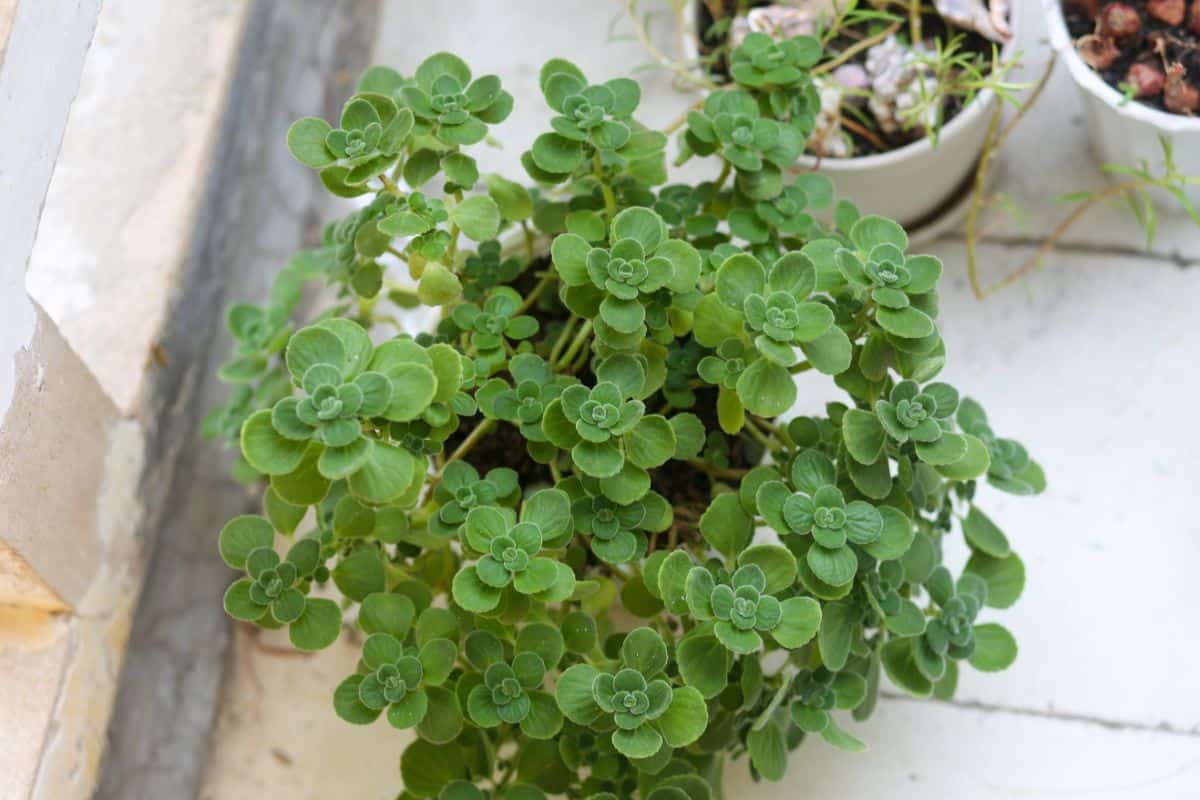
Drainage is as important in a container as it is in soil. There’s no point in having well-draining soil if the excess water has nowhere to go, so try to avoid using pots without drainage holes if possible. No matter how cute that pot without a drainage hole is, it’s not the ideal choice for succulents.
Without drainage holes, you need to be incredibly precise in your watering habits. While it would be nice to have watering down to a science, few gardeners have the expertise to do so.
You’ll also want to avoid lining the bottom of your pot with rocks as this creates a perched water table and actually exposes your Vicks Plant’s roots to more water.
The material your pot is made of will also contribute to your watering schedule, so it’s important to choose wisely. Terracotta pots have a habit of absorbing excess moisture, which can help prevent accidental overwatering. Glazed ceramic or plastic pots cannot do this, so you need to be aware of this when determining how often to water your succulents.
Check Also: Edithcolea Grandis
Vicks Plant Propagation
Not only is the Vicks Plant easy to grow, but it’s also incredibly easy to propagate. Whether you choose to propagate with offsets, cuttings, or seeds, the Vicks Plant won’t present much of a challenge. This means it’s a great propagation choice for any gardener, whether new to succulents or with years of experience.
Offsets
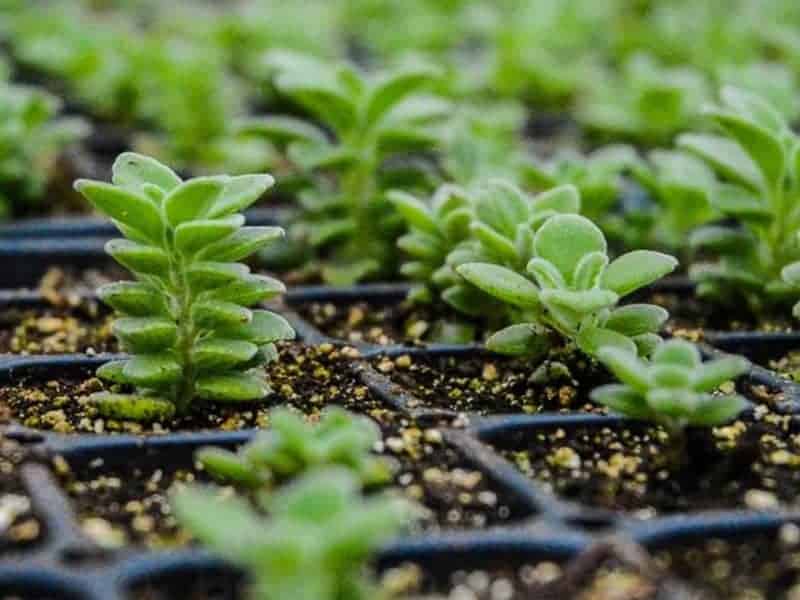
One of the easiest propagation methods is offset separation. The reason for this is that the offsets produced around the base of your plant are basically ready to grow with little effort on your part. They already have their own root system and just need to be divided from the mother plant.
To separate the offsets from the parent plant, it’s easiest to use your fingers to gently tug the tiny Vicks Plant out of the soil. Be sure to grasp it near the base of the plant to avoid any accidental damage. You can also use a sharp, clean knife to gently separate the roots. If needed, you may also brush away the topsoil to have a better view of the roots.
Once you’ve removed the offset from the soil, you’ll need to give it a few days to callous before you can plant it in new soil. This is to prevent the possibility of infection from fungus or bacteria through the plant’s open wounds.
After a couple of days, the Vicks Plant pup is ready to be transplanted into its own container. From this point forward, you can simply treat the plant just as you would any other mature Vicks Plant. With time, it will grow to maturity and produce its own offsets.
Cuttings
Cuttings are another simple method of Vicks Plant propagation. They are easy to collect and just as easy to grow. If you want a fuller-looking pot, be sure to collect several cuttings so they can all be placed in the same container.
To collect cuttings from your Vicks Plant, use a sharp pair of scissors or gardening shears to snip away a section of the plant. The size does not matter, but if your mature plant needs pruning, feel free to take a larger cutting.
After you’ve collected your cuttings, you’ll need to do just as you would with offsets and give them a few days of air drying to let their wounds callous. Once the cuttings have calloused, you’re ready to move them to new soil.
Some gardeners recommend using a rooting aid such as rooting hormone powder, but this step is entirely optional. Some gardeners swear by it, others are indifferent. It can help hasten rooting, but it’s up to you whether you use a rooting aid or not.
Next, you’ll place the cuttings into well-draining soil. Again, you can place a single cutting in a container or several at once for a fuller-looking plant.
If you’re looking for a different method of cutting propagation, you can also place the cuttings into a container of water rather than soil. You’ll have to change the water occasionally to make sure it stays clean, but otherwise, the process is nearly the same.
Regardless of whether you propagate in soil or water, it can take up to several weeks before you begin to see root growth. Once the roots appear, you can begin treating the cuttings just as you would a mature Vicks Plant.
You May Also Like: Kalanchoe 'Pink Butterflies'
Seeds
The final method of Vicks Plant propagation is with seeds. If you already have Vicks Plants in your garden that regularly bloom, you can try collecting the seeds yourself. Otherwise, you’ll need to purchase seeds from a reputable vendor. There are plenty of great seed vendors online that can provide you with healthy Vicks Plant seeds.
Once you have the seeds, you’re ready to plant. It’s recommended to use a seed tray or other shallow container. The seeds require light in order to germinate, so just sprinkle them across the surface of the soil rather than burying them.
Keep the seeds out of direct light and be sure to keep the soil moist, but not overly wet. Soil that is too wet can cause the seeds to rot. It can be helpful to cover the seed tray to help conserve moisture as well as misting rather than regular watering. It’s also recommended to keep the seeds at a steady temperature of around 70 degrees Fahrenheit.
After a few weeks, you should notice tiny Vicks Plant seedlings sprouting from the surface of the soil. Once most of the seeds have sprouted, you can remove the cover. It’s still best to avoid direct sunlight at this point as the seedlings can be quite delicate.
Once the seedlings have grown to a size that seems sturdier, you can consider transplanting them to their own containers. Be sure to introduce the seedlings to direct sunlight slowly over a period of several weeks to give them time to adapt to increased light levels.


